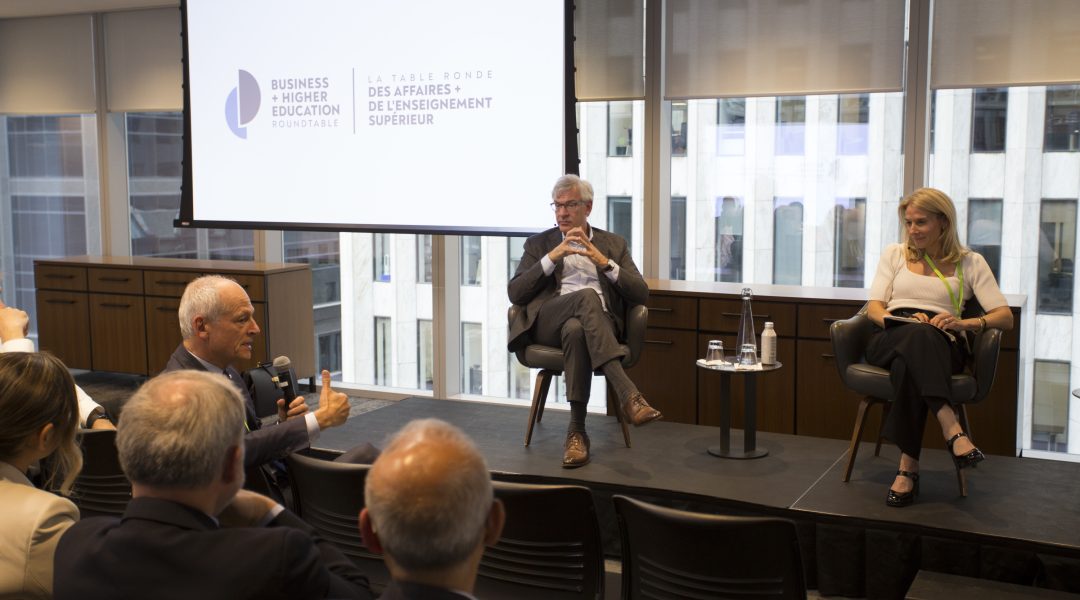
Navigating the AI Revolution
BHER members, as Canada’s leading businesses + higher education institutions, are at the forefront of dealing with the risks and opportunities of the AI revolution.
From tech adoption to productivity lags, from public-private collaborations to innovating in the age of disruption, and from the human skills needed to complement AI to how to train, recruit, and retain talent with those skills, BHER members not only have a keen sense of what’s important but also what needs to be done next.
We convened leaders from top businesses and post-secondaries across the country in October 2023 at Deloitte Canada’s headquarters. Here are the key issues they identified:
- Canada’s commercial AI adoption lag is an opportunity for growth, but only if we can overcome what’s causing it. Cross-sectoral barriers to AI adoption and productivity include distrust of the technology’s reliability, low risk tolerance by clients, the outsized power of American monopolies, ethical concerns, and lack of early collaboration between research and private industry. Addressing these challenges is a priority. So too is defining the limits we cannot change (e.g. our commitments to equity and information privacy, which make us less competitive internationally) and creating policies to work within them.
- Businesses and post-secondary institutions (PSIs) need to collaborate earlier, more, and across different sectors. PSIs will play a major role in training the tech workforce, but as tech development accelerates, academic researchers, creators, and users should also be collaborating well before the production stage. Acceleration will outpace the rate at which institutions can teach tech-specific knowledge in the classroom, making hands-on and experiential learning more important than ever. Industry leaders see AI less as decreasing jobs and more as increasing the capacity of each worker.
- Complex human skills are least likely to be impacted by AI, which means we cannot afford to lose humanities departments. Post-secondary leaders know that the push for STEM investment has left arts and humanities departments behind at many institutions. The skills that AI can’t replace—creativity, critical thinking, decision making—are the foundation of arts and humanities training. Year over year, human skills top the list on BHER’s Skills Survey when we ask employers what skills they look for most when hiring.
- Human input is still needed in AI processes. Current generative AI technologies are not perfectly reliable, and no one can predict if they ever will be. Far-sighted leaders worry that while the current workforce is able to catch compounding mistakes in data over time we may lose the ability to question what comes out of the machine through overreliance. Beyond strengthening the skills AI can’t replace, businesses and institutions should ensure workers have some understanding of the processes behind what AI replicates.
Our group also came up with calls for action:
- Early co-creation and collaboration between public and private sectors, not only in product design but also in market research, policy, and ethics, to maximize buy-in, practical solutions to real-world problems, and impact. You can’t build a product for a customer without working closely with the customer to identify issues, lived realities, and blindspots. Historically, researchers in Canada’s PSIs and industry have remained siloed, but getting both sides to recognize the value of collaboration will be an important next step.
- Increase work-integrated learning (WIL), at the undergraduate level and for graduate students. Many PhDs struggle to enter Canada’s labour market and/or leave the country after graduation, which means Canada is underutilizing or missing out on highly trained talent. WIL helps undergraduates gain applied skills training and access to industry sooner, i.e. before they graduate, and it can help train and retain graduate students as well. We can’t afford to under-prepare or lose skilled talent in the age of AI.
- More humanities. The key word in Large Language Models (LLMs) is language. The future of work calls for more well-rounded people who can make the best use of AI through human skills that complement what AI can achieve. If we create as many pathways for non-arts students to take a basic linguistics class as we do for non-computer science students to take an introductory coding class, we would create a workforce that can use AI technologies more productively.
- Stay vigilant about the biases and inequalities that AI can perpetuate. Excitement about how AI can level the playing field for entry-level skills needs to be tempered by caution about existing inequalities reflected in the data used to train AI. Deloitte’s survey of Canadian companies found that 86% are concerned about the ethical implications of AI, especially in regards to bias and diversity, equity, and inclusion (DEI). As generative AI takes on more of the workload, moving the focus to evaluating, validating, and critically interrogating what AI produces will help to safeguard both factual accuracy and deeper ethical issues.
Download the Thought Leadership piece